
Register your product and get support at
HD9342
www.philips.com/welcome
EN User manual
RU Руководствопользователя
UK Посібниккористувача
3140 035 31151
English
Русский
1 Important
Read this user manual carefully before you use
the appliance, and save the user manual for future
reference.
Danger
• Do not immerse the appliance or the base in water
or any other liquid.
Warning
• Check if the voltage indicated on the appliance
corresponds to the local mains voltage before you
connect the appliance.
• Do not use the appliance if the plug, the mains cord,
the base or the appliance itself is damaged.
• If the mains cord is damaged, you must have it
replaced by Philips, a service centre authorised by
Philipsorsimilarlyqualiedpersonsinorderto
avoid a hazard.
• This appliance is not intended for use by persons
(including children) with reduced physical, sensory
or mental capabilities, or lack of experience and
knowledge, unless they have been given supervision
or instruction concerning use of the appliance by a
person responsible for their safety.
• Children should be supervised to ensure that they
do not play with the appliance.
• Keep the mains cord out of the reach of children.
Do not let the mains cord hang over the edge of
the table or worktop on which the appliance stands.
Excess cord can be stored in or around the base of
the appliance.
• Hot water can cause serious burns. Be careful when
the kettle contains hot water.
• Neverllthekettlebeyondthemaximumlevel
indication.Ifthekettlehasbeenoverlled,boiling
water may be ejected from the spout and cause
scalding.
• Do not touch the body of the kettle during and
some time after use, as it gets very hot. Always lift
the kettle by its handle.
• Do not open the lid while the water is heating
up or boiling. Be careful when you open the lid
immediately after the water has boiled: the steam
coming out of the kettle is very hot.
• Only use the kettle in combination with its original
base.
• This rapid-boil kettle can draw up to 9.2 amps from
the power supply in your home. Make sure that
the electrical system in your home and the circuit
to which the kettle is connected can cope with this
level of power consumption. Do not let too many
other appliances draw power from the same circuit
while the kettle is being used.
• This appliance can be used by children aged from 8
years and above if they have been given supervision
or instruction concerning use of the appliance
in a safe way and if they understand the hazards
involved. Cleaning and user maintenance shall not be
made by children unless they are older than 8 and
supervised. Keep the appliance and its cord out of
reach of children aged less than 8 years.
Caution
• Appliances can be used by persons with reduced
physical, sensory or mental capabilities or lack of
experience and knowledge if they have been given
supervision or instruction concerning use of the
appliance in a safe way and understand the hazards
involved.
• The kettle is only to be used with the base provided.
• In order to avoid a hazard due to inadvertent
resetting of the thermal cut-out, this appliance
must not be supplied through an external switching
device, such as a timer, or connected to a circuit that
is regularly switched on and off by the utility.
• Alwaysplacethebaseandthekettleonadry,at
and stable surface.
• As the kettle make of glass, it has to be handled
carefully and avoid colliding to the water tap during
waterlling.
• When the kettle is broken or crack, stop to use
immediately.
• The kettle is only intended for boiling water. Do not
use it to heat up soup or other liquids or jarred,
bottled or tinned food.
• Neverllthekettlebelowtheminimumlevelto
prevent the kettle from boiling dry.
• Depending on the hardness of the water in your
area, small spots may appear on the heating element
of your kettle when you use it. This phenomenon is
the result of scale build-up on the heating element
and on the inside of the kettle over time. The harder
the water, the faster scale builds up. Scale can occur
in different colours. Although scale is harmless, too
muchscalecaninuencetheperformanceofyour
kettle. Descale your kettle regularly by following the
instructions given in the chapter ‘Descaling’.
• Some condensation may appear on the base of the
kettle. This is perfectly normal and does not mean
that the kettle has any defects.
• This appliance is intended to be used in household
and similar applications such as:
• Staffkitchenareasinshops,ofcesandother
working environments;
• Farm houses;
• By clients in hotels, motels and other residential
type environments;
• Bed and breakfast type environments.
Boil-dry protection
This kettle is equipped with boil-dry protection. This device automatically switches off the kettle if it
is accidentally switched on when there is no water or not enough water in it. The on/off switch will
move to off position and power-on light off. Let it cool down. The kettle is ready for use again.
Electromagneticelds(EMF)
Electromagneticelds(EMF)
ThisPhilipsappliancecomplieswithallstandardsregardingelectromagneticelds(EMF).If
handled properly and according to the instructions in this user manual, the appliance is safe
tousebasedonscienticevidenceavailabletoday.
Recycling
Your product is designed and manufactured with high quality materials and components,
which can be recycled and reused.
When you see the crossed-out wheel bin symbol attached to a product, it means the
product is covered by the European Directive 2002/96/EC:
Never dispose of your product with other household waste. Please inform yourself about
the local rules on the separate collection of electrical and electronic products. The correct
disposal of your old product helps prevent potentially negative consequences on the
environment and human health.
Guarantee and service
If you have a problem, need service, or need information, see www.philips.com/support or
contact the Philips Consumer Care Center in your country. The phone number is in the
worldwideguaranteeleaet.IfthereisnoConsumerCareCenterinyourcountry,goto
your local Philips dealer.
2 Your glass kettle
CongratulationsonyourpurchaseandwelcometoPhilips!Tofullybenetfromthesupport
that Philips offers, register your product at www.philips.com/welcome.
3 Overview
a Spout
b Water-level indicator
c Base
d On/offswitch(I/O)
e Lid release button
f Lid
4 Use your glass kettle
Note
• Make sure that the lid is properly closed to prevent the kettle from boiling dry.
Cleaning and Descaling:
• Always unplug the appliance before you clean it.
• Never use scouring pads, abrasive cleaning agents or aggressive liquids such as petrol or
acetone to clean the appliance.
• Never immerse the kettle or its base in water.
5 Clean your glass kettle
Clean the outside of the kettle with a soft, damp cloth moistened with warm water and
some mild cleaning agent.
6 Descale your glass kettle
Regular descaling prolongs the life of the kettle.
In case of normal use (up to 5 times a day), the following descaling frequency is
recommended:
• Once every 3 months if you use soft water (up to 18dH).
• Once every month if you use hard water (more than18dH).
Descale the kettle as follows:
1 Fill the kettle with water up to three-quarters of the maximum level and bring the
water to the boil.
2 After the kettle has switched off, add white vinegar (8% acetic acid) to the maximum
level.
3 Leave the solution in the kettle overnight.
4 Empty the kettle and rinse the inside thoroughly.
5 Fill the kettle with fresh water and boil the water.
6 Empty the kettle and rinse it with fresh water again.
7 Repeat the procedure if there is still some scale in the kettle.
Note
• You can also use an appropriate descaler. In that case, follow the instructions of the
descaler.
7 Storage
Store the mains cord by winding it round the reel in the base of the appliance.
8 Replacement
If the kettle, the base or the mains cord of the appliance is damaged, take the base or the
kettle to a service centre authorised by Philips for repair or replacement of the cord to avoid
a hazard.
1 Важнаяинформация
Передэксплуатациейприборавнимательно
ознакомьтесьснастоящимруководствоми
сохранитеегодлядальнейшегоиспользованияв
качествесправочногоматериала.
Опасно!
• Запрещаетсяпогружатьчайникилиподставку
чайникавводуилилюбуюдругуюжидкость.
Внимание!
• Передподключениемприбораубедитесь,что
указанноенанемноминальноенапряжение
соответствуетнапряжениюместной
электросети.
• Непользуйтесьчайником,еслиповрежден
сетевойшнур,штепсельнаявилка,подставка
чайника,либосамчайник.
• Вслучаеповреждениясетевогошнураего
необходимозаменить.Чтобыобеспечить
безопаснуюэксплуатациюприбора,заменяйте
шнуртольковавторизованномсервисном
центреPhilipsиливсервисномцентрес
персоналомвысокойквалификации.
• Данныйприборнепредназначендля
использованиялицами(включаядетей)с
ограниченнымиинтеллектуальнымиили
физическимивозможностями,атакжелицами
снедостаточнымопытомизнаниями,кроме
случаевконтроляилиинструктированияпо
вопросамиспользованияприборасостороны
лиц,ответственныхзаихбезопасность.
• Непозволяйтедетямигратьсприбором.
• Хранитесетевойшнурвнедоступномдлядетей
месте.Недопускайтесвисанияшнураскрая
столаилиместаустановкиприбора.Излишек
шнураможнохранитьвотсекедляшнураили
намотатьнаподставкуприбора.
• Кипятокможетстатьпричинойсерьезных
ожогов.Будьтеосторожныприобращениис
чайником,содержащимкипяток.
• Запрещаетсянаполнятьчайниквышеотметки
максимальногоуровня.Вслучаепревышения
отметкимаксимальногоуровнякипящаявода
можетвыливатьсяизносикаистатьпричиной
ожогов.
• Неприкасайтеськстенкамчайникавовремяи
некотороевремяпослекипяченияводы—он
становитсяоченьгорячим.Поднимайтечайник,
обязательновзявшисьзаручку.
• Неоткрывайтекрышку,покавода нагревается
иликипит.Будьтеосторожныприоткрывании
крышкисразупослекипяченияводы—
выходящийизчайникапароченьгорячий.
• Используйтечайниктолькосподставкой,
входящейвкомплектпоставки.
• Чайникнагреваетводуоченьбыстро;он
можетпотреблятьдо9,2ампериздомашней
электросети.Убедитесь,чтоэлектрическаясеть
вВашемдомеицепь,ккоторойподключен
чайник,способнывыдержатьтакойуровень
энергопотребления.Старайтесьнеподключать
коднойцепислишкоммногодругихприборов
одновременносработающимчайником.
• Этимприбороммогутпользоватьсядети
старше8лет,нотолькоподприсмотромили
послеполученияинструкцийпобезопасному
использованиюприбора.Детимогут
осуществлятьочисткуиуходзаприбором,
толькоеслионистарше8летитолькопод
присмотромвзрослых.Хранитечайникишнурв
месте,недоступномдлядетеймладше8лет.
Предупреждение
• Приборамимогутпользоватьсялицас
ограниченнымиинтеллектуальнымиили
физическимивозможностями,атакже
лицаснедостаточнымопытомизнаниями
подприсмотромдругихлицилипосле
инструктированияобезопасномиспользовании
прибораипотенциальныхопасностях.
• Чайникможноиспользоватьтолькос
прилагаемойподставкой.
• Воизбежаниевозникновенияопасной
ситуациииз-заслучайногосбросааварийного
предохранителя,неподключайтеприборк
внешнимотключающuмустройствам,например,
ктаймеру,иликсети,вкоторойвозможнысбои
подачиэлектропитания.
• Ставьтеподставкуичайниктольконасухую,
ровнуюиустойчивуюповерхность.
• Таккакчайниксделанизстекла,снимследует
обращатьсяосторожноинаполнятьеговодой
аккуратно,избегаяударововодопроводный
кран.
• Припоявленииповрежденийилитрещин
следуетнемедленнопрекратитьиспользование
чайника.
• Чайникпредназначентолькодлякипяченияводы.
Неиспользуйтеегодляразогревасупаилииных
жидкостей,илиразогреваконсервированной
пищи,бутилированнойпищииликонсервов.
• Никогданеналивайтевчайникводуниже
минимальногоуровня,чтобыпредотвратить
выкипание.
Specifications are subject to change without notice
© 2012 Koninklijke Philips Electronics N.V.
All rights reserved.
HD9342_UM_01


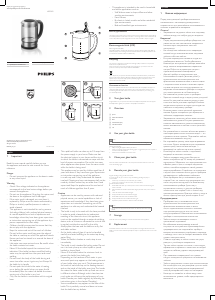

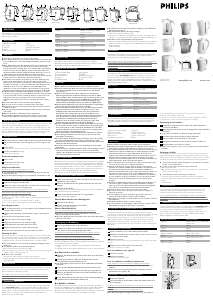
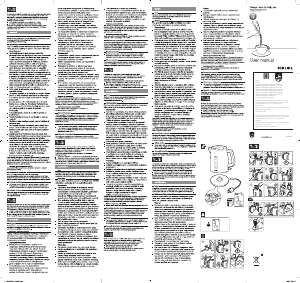
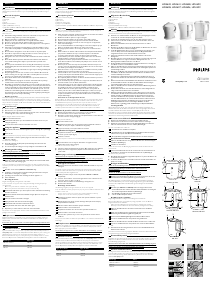
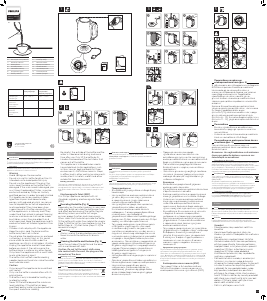
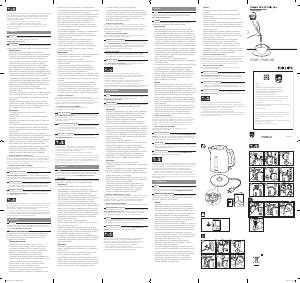
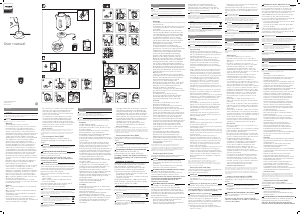
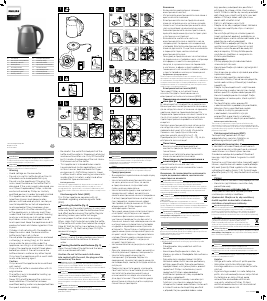
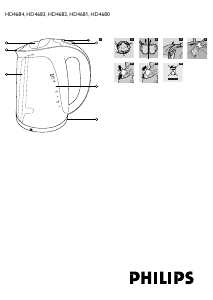
Praat mee over dit product
Laat hier weten wat jij vindt van de Philips HD9342 Waterkoker. Als je een vraag hebt, lees dan eerst zorgvuldig de handleiding door. Een handleiding aanvragen kan via ons contactformulier.